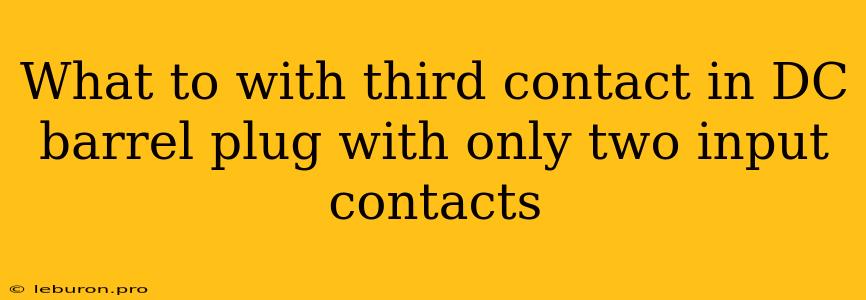The DC barrel plug, a ubiquitous connector in the world of electronics, is usually designed with two contacts: a central positive contact and an outer negative contact. However, certain applications may require a third contact in the barrel plug, leading to confusion about its purpose. This article will delve into the mystery surrounding the third contact in a DC barrel plug, explaining its potential functionality and providing insights into how it might be used.
Understanding the Basics of DC Barrel Plugs
Before exploring the third contact, it's essential to understand the fundamental workings of a typical DC barrel plug. These connectors are primarily used for power delivery, with the central positive contact carrying the positive voltage and the outer negative contact providing the ground return path.
The Standard Two-Contact Configuration
The standard DC barrel plug design features two contacts, a positive and a negative, that are essential for carrying electrical current. The positive contact, usually a pin in the center of the barrel plug, connects to the positive terminal of the power source. The negative contact, a sleeve surrounding the pin, connects to the negative terminal.
The Role of the Third Contact
While uncommon, some DC barrel plugs incorporate a third contact, typically a smaller pin located alongside the central positive contact. This additional contact, known as the sense contact, serves a specific purpose, often related to communication or control signals.
Possible Functions of the Third Contact:
- Remote Control: The third contact can transmit control signals from the connected device to the power source, allowing for features like remote power on/off, brightness adjustment, or other functionalities.
- Voltage Feedback: The third contact can carry a voltage signal back to the power source, providing feedback on the voltage level at the connected device. This allows the power source to adjust its output voltage to ensure optimal performance.
- Data Transfer: In some applications, the third contact might be used for data transfer between the connected device and the power source. This is often employed in situations where a combination of power and data transmission is required.
- Safety Ground: In rare cases, the third contact may be used as a safety ground, providing an additional path to earth for electrical currents. This is usually implemented in devices that require an extra level of safety.
Identifying the Third Contact
Determining the function of the third contact requires careful examination and documentation. The best way to understand its purpose is to:
- Consult the Device Manual: The manual for the device using the DC barrel plug will often specify the function of the third contact.
- Examine the Plug's Design: Look closely at the physical design of the plug. The location and size of the third contact might provide clues about its purpose.
- Check for Documentation: There might be documentation accompanying the DC barrel plug or the connected device that explains the purpose of the third contact.
Compatibility and Safety Considerations
It's crucial to ensure compatibility and safety when working with DC barrel plugs, especially those featuring a third contact. Using the wrong plug or misinterpreting the contact's function can lead to device damage or even safety hazards.
Compatibility:
- Voltage Matching: The voltage rating of the power source and the connected device must match to avoid damaging the equipment.
- Current Capacity: The current capacity of the power source and the device must be compatible to prevent overloading.
- Polarity: The positive and negative connections must align correctly to ensure proper operation.
Safety:
- Grounding: If a third contact serves as a safety ground, ensure a proper connection to a ground point.
- Short Circuits: Take care to prevent short circuits by ensuring the third contact is not connected to the positive or negative contacts unless specifically designed for this purpose.
Conclusion
While uncommon, a third contact in a DC barrel plug can enhance functionality by adding communication, control, or safety features. Understanding the purpose of this contact requires careful examination of documentation, design, and potential applications. By correctly identifying and understanding the function of the third contact, you can ensure safe and efficient operation of your devices and power sources, making the most of the versatility offered by DC barrel plugs.
